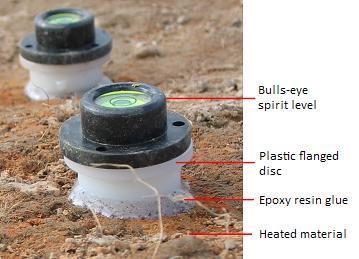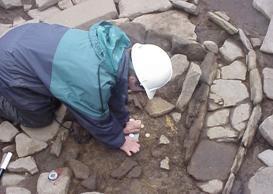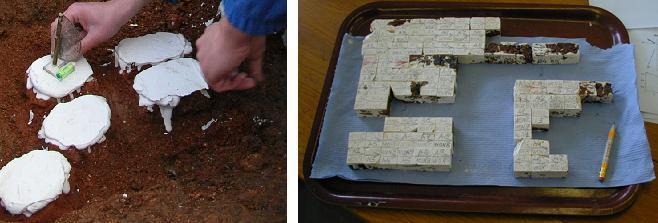Sample collection
Archaeomagnetic dating by direction requires a material to be in situ, and it must not have been disturbed since the magnetic signal was obtained. The aim of sample collection is to remove material from a feature in a way that does not damage the record of the Earth's magnetic field within the material. The samples must also be oriented with respect to true north; if a magnetic compass is used, magnetic north is recorded and a correction applied to the measured information to take into account the difference between true and magnetic north.
There are three principal sampling techniques used in the UK, based on the methods described by Clark et al. (1988) and Linford (2006):
- Disc collection
- Tube collection
- Bulk sample collection
It is sometimes necessary to consolidate particularly friable features in the field before the samples can be collected. This should be discussed with the archaeomagnetists when the feature is first revealed.
Each individual specimen of sampled material must be a minimum of 1cm3. The discs used to sample hard-fired material are 2.54cm in diameter; the tubes used to sample softer material are 2.54cm tall with a diameter of 2.54cm. A minimum of eight specimens should be collected from a feature, but ideally 15-20 specimens should be collected so that all areas of the feature can be investigated. It is important to note that the sampling procedure does require some material to be removed which will cause damage to the surface being sampled. This needs to be considered when deciding to use archaeomagnetic dating, especially if the features are to be conserved for public display.
The disc collection method
This method uses plastic flanged discs to sample hard-fired features that are relatively robust. The plastic reference discs are glued directly on to the heated material using an epoxy resin glue, such as Araldite. It is essential that the disc is level, which is checked using a small bulls-eye spirit level that is monitored until the glue has completely dried.
Once the glue has dired, an orientation line needs to be drawn directly on top of the disc marking the direction of north (or magnetic north if a magnetic compass is used) at the time of sample collection. A sample code also needs to be written on the disc, which can then be transferred to a sketch plan.
Image copyright S.J. Clelland, University of Bradford.

The tube collection method
Small plastic tubes are used to sample softer materials. The tubes are positioned over the specific sample location before being pushed into the material using a Perspex plate. A bulls-eye spirit level is placed on the Perspex plate, directly over the position of the tube so that the tube is inserted into the material level. Once the tube is inserted, the orientation of the modern field and the sample codes can be drawn directly on to the tube.

Image copyright S.J. Dockrill, University of Bradford.
The bulk sample collection method
This method completely encapsulates the feature in a strong material, such as plaster of paris, so that large bulk samples are removed from the feature. Once the material used to encapsulate the feature is dry, the orientation of the modern field and the sample codes can be drawn directly on to the material. In the laboratory, the sampled material can then be cut into individual specimens from the bulk sample, using either a drill or a saw to cut the samples into small cubes.

Image copyright M. Hounslow, University of Lancaster.
